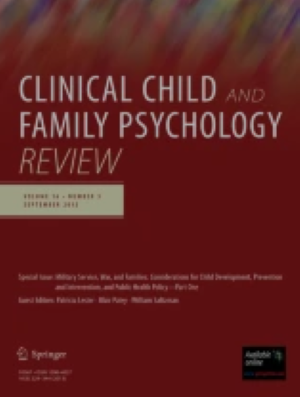儿童和青少年共病性创伤后应激障碍和饮食失调的患病率、病因学和治疗:系统综述。
IF 6.1
1区 心理学
Q1 PSYCHOLOGY, CLINICAL
引用次数: 0
摘要
儿童创伤暴露与精神疾病的发展有关,包括饮食失调(EDs)和创伤后应激障碍(PTSD)。一项对成人PTSD和ED合并症的系统综述发现,这种合并症的患病率相对较高,并且与这种合并症相关的ED症状更严重。然而,尽管儿童和年轻人由于神经发育的敏感性,对精神疾病的易感性增加,但对PTSD和ED合并症的关注却较少。本系统综述旨在综合儿童和年轻人(后者由世界卫生组织定义为10-25岁)中并发PTSD和ed的研究,检查患病率、病因和治疗。六个电子数据库(PubMed, PsychInfo, Scopus, APA PsychNET, Web of Science和Embase)检索了1990年至2024年发表的文章,其中包括年龄在25岁以下的参与者,他们要么在研究中被评估为符合ED和PTSD的标准,要么被报道患有ED和PTSD。从24项研究中提取并综合了数据。PTSD在年轻ed患者中的患病率从0%到46.4%不等,暴饮暴食和排泻性ed患者的患病率更高,如神经性贪食症和暴饮暴食型厌食症。与合并症相关的危险因素包括创伤严重程度、狂饮行为和情绪调节不良。没有研究评估这一人群的治疗结果。总的来说,当前的综述强调,虽然同时发生的PTSD和EDs在年轻人中是一种相对常见的精神共病,但现有的文献并没有充分解释这种共病的发展或它如何影响对治疗的反应。未来的研究需要澄清因果途径,了解这种共病的发展轨迹,并评估这种精神共病对治疗结果的影响。本文章由计算机程序翻译,如有差异,请以英文原文为准。
Prevalence, Aetiology and Treatment of Comorbid Post-traumatic Stress Disorder and Eating Disorders in Children and Young People: A Systematic Review.
Childhood trauma exposure is associated with the development of psychiatric disorders including Eating Disorders (EDs) and Post-Traumatic Stress Disorder (PTSD). A systematic review of comorbid PTSD and EDs in adults found relatively high prevalence rates of this comorbidity and more severe ED symptoms associated with this comorbidity. However, there has been less focus on comorbid PTSD and ED in children and young people, despite this group's increased susceptibility to psychiatric conditions due to their neurodevelopmental sensitivity. This systematic review aimed to synthesise research on co-occurring PTSD and EDs in children and young people (the latter group defined by the World Health Organisation-WHO-as aged 10-25 years), examining prevalence, aetiology, and treatment. Six electronic databases (PubMed, PsychInfo, Scopus, APA PsychNET, Web of Science and Embase) were searched for articles published from 1990 to 2024 which included participants aged under and up to 25 years who were either assessed as meeting criteria for both an ED and PTSD in the study, or were reported to have had a pre-existing diagnosis of ED and PTSD. Data from 24 studies were extracted and synthesised. PTSD prevalence among young people with EDs ranged from 0% to 46.4%, with higher rates observed in binging and purging-related EDs such as Bulimia Nervosa and binge-purge type anorexia. Risk factors associated with the comorbidity included trauma severity, binge-purging behaviours, and poor emotion regulation. No studies assessed treatment outcomes for this population. Overall, the current review highlights that, while co-occurring PTSD and EDs represents a relatively common psychiatric comorbidity in young people, the existing body of literature does not adequately explain the development of this comorbidity or how it impacts response to treatment. Future research is needed to clarify causal pathways, understand developmental trajectories of this comorbidity, and evaluate the impact of this psychiatric comorbidity on treatment outcomes.
求助全文
通过发布文献求助,成功后即可免费获取论文全文。
去求助
来源期刊

Clinical Child and Family Psychology Review
PSYCHOLOGY, CLINICAL-
CiteScore
10.50
自引率
4.30%
发文量
45
期刊介绍:
Editors-in-Chief: Dr. Ronald J. Prinz, University of South Carolina and Dr. Thomas H. Ollendick, Virginia Polytechnic Institute Clinical Child and Family Psychology Review is a quarterly, peer-reviewed journal that provides an international, interdisciplinary forum in which important and new developments in this field are identified and in-depth reviews on current thought and practices are published. The Journal publishes original research reviews, conceptual and theoretical papers, and related work in the broad area of the behavioral sciences that pertains to infants, children, adolescents, and families. Contributions originate from a wide array of disciplines including, but not limited to, psychology (e.g., clinical, community, developmental, family, school), medicine (e.g., family practice, pediatrics, psychiatry), public health, social work, and education. Topical content includes science and application and covers facets of etiology, assessment, description, treatment and intervention, prevention, methodology, and public policy. Submissions are by invitation only and undergo peer review. The Editors, in consultation with the Editorial Board, invite highly qualified experts to contribute original papers on topics of timely interest and significance.
 求助内容:
求助内容: 应助结果提醒方式:
应助结果提醒方式:


